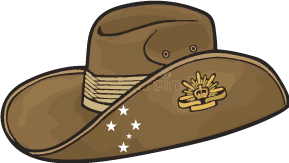Sandra's Guide to finding WW1 Australian veteran information.
Compiled by Sandra Young, 2021
Before you start your search carefully check the following:
1. Check their surname is correct. You sometimes may have to use places like the NSW BDM (births, deaths and marriages) online historical online information.
2. You can also sometimes trace them backwards from their death notices using the online Ryerson Index, which suggests what newspaper carried their death notice, assuming their death notice was placed in a paper.
3. Sometimes they may have used a nickname, middle name etc, instead of their listed first name, so searching for them using their nickname may not help find your veteran.
4. If they were known to use an alias, for their enlisted name, that should help you find this veteran. (Try the AIF Project online site for many, but not all, known aliases.)
5. If you know when and where they were born, that can often make the search easier. You can usually check this, if you do not already know it, by using such state online websites as the NSW births deaths and marriages site, using its historical section.
To search for Australian veterans, use the Australian National Archives site. (Remember there is a UK National Archives website for UK veterans, so if you just search for National Archives, both the UK and Australian National Archive sites will appear.) (It holds the service records for Australian WW1, and some Boer War veterans.) (Later WW2, Vietnam, Korean War etc have separate online websites that can be searched)

In the (Australian) National Archive site, choose the “Search the Collection” option.
Then go into “Record Search”

If the surname is a common one, try to use the “Advanced Search” option.
As an example, a surname of Smith who was a lieutenant in the 1st battalion, results in one person.

Usually you would try a basic search, but only use their first name, or initial and surname.
If they have perhaps Smith Alfred John, only use either Smith Alfred, or Smith A, as the record searches do not seem to like too many initials.
If it is an unusual surname you could try a name search, then refine the search by adding the first name or initial.
Sometimes if your veteran cannot be found, going to the Australian War Memorial’s website and searching through the WW1 Embarkation Rolls, without worrying about filling out the date they departed, their ship etc., may suggest your veteran.

This embarkation roll usually lists their service number, although officers were not given service numbers, unless they had been promoted from lower ranks that had service numbers, but it does lists some family information etc., which may be helpful.
Many WW1 early volunteers, initially, if they changed battalions etc, they were issued with a new service number, with each change so many veterans may have a few changed service numbers on their files, and each number was not unique to one serviceman, so many people ended up with similar numbers for their service number.
(It was only in later years, such as later wars, that servicemen and women were issued with individual service numbers which remained attached to that person for the length of their service.)
Nurses were not given service numbers and their WW1 records are not listed on the National Archives website.
If your veteran died in the WW1, you can search the Commonwealth War Graves Commission website and the Australian War Memorial Honour Roll for more information about your veteran. If you only know their name and the date of their death, search the Commonwealth War Graves Commission website, and the AWM Honour Roll, as the information you may have may be slightly inaccurate. (Search for a few days, or perhaps months or years in the CWGC website as your date of death may be incorrect) If you only know a name, that they died and were perhaps buried in France, check the Commonwealth War Graves Commission website, or if they were an Australian veteran, the AWM Honour Roll. Remembering that mistakes in spelling do occur on some official documents, and even on the National Archive records, veterans have spelling mistakes etc on their own hand-written records, so you need to double-check information if your veteran cannot be found. If they enlisted overseas, their records might be in the UK National Archives website records, or the NZ Archives etc.
Some veterans perhaps enlisted in one country and later transferred from perhaps Australian service into British, for instance, if they joined the Royal Flying Corps after first being in the Australian AIF.
Most Australian WW1 veteran information can be easily found, but some information needs some detective work to ferret it out.
References
The (Australian) National Archives.
The Australian War Memorial for WW1 Embarkation Rolls, Rolls of Honour, listed Awards or Medals, some WW1 Red Cross Enquiries for veteran information.
The online AIF Project for many, but not all, aliases used by WW1 Australain veterans.
The Commonwealth War Graves Commission.
Th Australian Ryerson Index, which provides indexes for many, but not all, funeral newspaer notices for many deaths, assuming a funeral notice was placed in some Australian papers that the Ryerson index has included in its data.
BDM information (Births, Deaths and Marriages).
(Most Australian states and territories have historical records that can be searched online.)
The Australian Cemeteries Index is also a useful Australian veteran reference, and it often contains images of graves.
(Donna Newton, Librarian of the Royal Australian Historical Society (RAHS), has suggested this is also a very useful reference.)

